ABSTRACT
The constant assessment of methods of disease control is essential in achieving production regularity and for ongoing increments in soybean productivity. Among the various diseases, the intensity of the white mold has been increasing, caused especially by the fungus Sclerotinia sclerotiorum (Lib.) de Bary. The present work has the objective to assess different seed treatments in association with fungicide application to control the white mold in soybean. The experimental design used was complete randomized blocks design with split plots. In the plots, the treatments were: control - no seed treatment; Certeza® (thiophanate methyl + fluazinam 45 + 60 g ha-1) and Trichodermil® (Trichodermaharzianum ‘1306’ 1.250 mL 100 kg-1 - 109 viable spores mL-1). In each seed treatment, the application was done on aerial part of subplots.The treatmentsin aerial part were: control (with no fungicides application); three applications of Derosal® (carbendazim) 1.000 gi.a./ha-1 in R1, R2 and R5.1; three applications of Cercobin 700 WP® (thiophanate methyl) 600 gi.a./ha-1 in R1, R2 and R5.1;Cercobin 700 WP® (thiophanate methyl) in R1, Sumilex (procimidone) 750 gi.a./ha-1 in R2 and Frowncide (fluazinam) 750 gi.a./ha-1 in R5.1.There were assessments on the emergence and height of the plants in V3 and the severity of the disease at the phenological stages R1, R3, R5.5 and R7. The variables thousand-grain weight, productivity and the economic analysis were determined after the harvesting of the plots. The treatments of seeds with thiophanate methyl+ fluazinam and Trichoderma harzianum and the applications of thiophanate methyl, procimidone and fluazinam on the aerial part stood out in the control of the disease. The net income showed that despite the high cost of the plant protection products, there were increases in the profitability of the crop.
Key words: White mold, Glycine max, Economic analysis.
The agricultural crop of greater growth in the Brazilian market is the soybean, which corresponds to 49% of cultivated area with grains, especially in the Midwest and South Regions. Currently, one of the barriers to the increase of its productivity in South America is the disease known as white mold, incited by the fungus Sclerotiniasclerotiorum (Lib.) de Bary. This disease has reported losses ranging from 10 to 20% of productivity, on average, in Brazil (Almeida et al., 2005), and losses ranging from 11.5 to 96% of productivity in an estimate made only in the Southern region of Brazil (Silva et al., 2011).
The control of white mold is difficult due to the permanence of viable S. sclerotiorum for a long time on the soil, which can remain on the soil for up to 11 years, keeping its pathogenic power intact. Similarly, the inefficiency of the chemical control, coupled with the high susceptibility of cultivars, causes facilitated contamination in cultivated areas (Leite, 2005).
Among the control measures of the disease, the ones which stand out as the most efficient ones are, when integrated, the crop rotation, the cultivation of non-host crops to the fungus allied to the formation of straw to the no-till farming system and the biological control with living beings antagonistic to the fungus that causes the white mold (Bolton et al., 2006). The presence of straw results in lower rates of incidence of the white mold, since the soil cover establishes a physical barrier increasing microbial activity in the soil of antagonistic fungus, in addition to restricting the ascospores dispersion in the air and inhibiting the formation of apothecia (Paula Junior et al., 2007). However, the most widely adopted crop succession system in the Southern region of Brazil is the soybean system (first harvest/summer) corn (second harvest/winter), the areas of crop rotation being sporadic, which results in a decrease, over time, of the soil cover (Alves Neto et al., 2016). As consequence, the aggressiveness, the incidence and the severity of the disease have increased in the soybean areas, due to the characteristics of the S. sclerotiorum, which has wide adaptability (Ito and Parisi, 2010).
The main measure used aiming the control of disease is the usage of resistant cultivar, however, there have not been reports about the discovery of genotypes resistant to the white mold of the soybean yet, as the genetic resistance regarding the host in complex and of low heritability, being limited to genotypes that present only partial resistance (Guo et al., 2008; Vuong et al., 2008). Accordingly, the usage of chemical fungicides becomes an alternative to the control of the white mold. However, the difficulty in obtaining complete coverage of the plant by the fungicides during the pulverization, besides the total prices of the products, which have high cost, are challenges to obtain a proper and effective application (Görgen et al., 2009).
In addition to the fungicides for the application in post-emergence of the crop, there are chemical fungicides and antagonistic microorganisms for the seed treatment, given that they might come from the field with mycelia of S. sclerotiorum (Maude, 1996). Thus, both methods are designed to ensure proper initial population, with more vigorous and resistant plants, delaying the onset of the disease.
The seed is the most efficient means of dissemination and survival of the pathogen. Under favorable conditions, it only takes 0.5% of infected seeds to produce an epidemic on the field, in addition to increasing the inoculum potential of each crop cycle (Halfeld-Vieira and Sousa, 2000). Some practices have been adopted without the technical recommendation of research institutions, expanding unbalanced use of crop protection products, as the application of carbendazim in dose 1.000 gi.a./ha-1, in an attempt to achieve suppression over S. sclerotiorum, mainly for being a fungicide with a relatively low cost when compared to fungicides specific to the white mold. This attempt to suppress S. sclerotiorum, may increase its resistance, besides causing unsatisfactory results in the control of the pathogen.
In this context, the objective of this work was to assess different seed treatments in association with the application of fungicides of aerial on the control of white mold in the soybean crop, with the determination of the economic analysis of the treatments.
The experiment was conducted at the Cristavel Farm, in the City of Cascavel, Paraná State, Brazil, located at an average altitude of 735 m, latitude 25° 02’00,35” South and longitude 53° 10’32,09” West, in glebe with slope of 1.5%, in the months of October of 2015 to February of 2016. The soil is classified as typical Dystrophic Red Latosol (EMBRAPA, 2013), with 3.60% of organic matter and the weather of the region, according to Köppen, is type subtropical Cfa, with a hot summer and a tendency towards the concentration of rainfall, winter of not frequent frosts without a defined season.
The annual average rainfall stands around 1.500 mm, presenting average temperatures in the summer exceeding 20°C and in the winter average temperatures below 18°C (IAPAR, 2016). The area has been conducted in no-till farming system for over 10 years, with crop rotation, soybean being cultivated in the summer: wheat, black oats, second harvest corn and canola in the winter, all crops fertilized exclusively with mineral fertilizers and according to the needs of the crop. The soil cover contained wheat straw (Triticum aestivum).
Before the installation of the experiment it was collected, at random, sclerotia in 5 points of 0,25 m2 and 0,05 m of depth, aiming to determine the amount of sclerotia in the area, which was of 21 m-2 in the glebe, according to the methodology described by Sartori et al. (2011). The cultivar used in the experiment was the NS 5909 RG ®, this is the most used cultivar in southern Brazil, with super-young cycle and maturity group 5.9, presenting indeterminate growth, purple flower, pubescence of grayish color and brown hilum. The sowing was held on the 17 of October of 2015 with a population of 355.000 viable seeds per hectare, with spacing of 0, 45 m. The cultural practices were performed with chemical control during the crop cycle, taking into account the levels of economic damage for the control of pests, diseases and weeds.
Three applications were made of Fox® (trifloxystrobin + protioconazol 45 + 60 g ha-1) in all treatments on the stages of R1, R3 and R5.5 aiming for rust control (Phakopsora pachyrhizi Syd. and P. Syd.) and target spot (Corynespora cassicola). The experimental design used was the randomized complete block design, with split plots, consisting of three seed treatments with four applications of fungicides on the aerial part of the plant, with five repetitions. In the plots the seed treatment factor was allocated, and in the subplots the factor was fungicide on aerial part. The main plots were allocated in the glebe measuring 18 m long x 5,5 m wide, with subplots allocated within the main plot with 4,5 m long x 5,5 m wide. The plots were spaced one meter apart, for uniformity in the application and, also, to facilitate the access and the severity assessments. The following seed treatments were tested (TS): TS 1: control, no seed treatment: TS 2: Certeza® thiophanate methyl + fluazinam 45 + 60 g ha-1 and TS 3: Trichodermil® Trichoderma harzianum ‘1306’ 1.250 mL 100 kg-1 - 109 viable spores mL-1.
On the subplots the different managements of fungicides (MF) were applied on the aerial part: MF 1: control no fungicide application: MF 2: three applications of Derosal® (carbendazim) 1.000 g i.a. ha-1 on R1, R2 and R5.1: MF 3: three applications of Cercobin 700 WP® (thiophanate methyl) 600 g i.a. ha-1 on R1, R2 and R5.1 and MF 4: Cercobin 700 WP® (thiophanate methyl) 600 g i.a. ha-1 on R1, Sumilex (procimidone) 750 g i.a. ha-1 on R2 and Frowncide (fluazinam) 750 g i.a./ha-1 on R5.1.
The applications were performed with a battery powered knapsack sprayer with a 20 liters capacity, PJB to 20c to Jacto® model, with a 1.5 meters long bar adapted with 3 nozzles distance of 0.5 meters between nozzles, with bar pressure regulated at 350 kPa and tank volume regulated to apply a flow of 150 L ha-1, with flat spray nozzle (fan) 110 02. The assessments of emergence and plant height were performed in V3, on 11/11/2015, 33 days after the sowing.
The assessments of severity of the disease white mold S. sclerotiorum, were based on the observation of the percentage of symptoms on the plant and were conducted at the phenological stages R1 (09/12/2016), R3 (16/12/2015), R5.5 (04/01/2016) and R7 (26/01/2016) and based on diagrammatic scale with ratings ranging from 5 to 90% of severity (Juliatti, 2010).
The thousand grain weight of soybean was determined from the weighing, on a precision balance, of 1000 grains. As for the productivity of the crop, it was determined from the manual harvest of five 4.5 m long lines, spaced in 0.45 m, representing 10.12 m2 of useful plot. The material collected and threshed and the mass determined on precision scale, standardized to 13% of moisture and extrapolating to productivity per hectare. The economic analysis included the net income to each applied treatment, discounting the cost of each application for each treatment of gross revenues. It was considered the cost in dollars per hectare of US$ 0.00 for plot without seed treatment: US$ 13.82 for seed treatment with thiophanate methyl + fluazinam: US$ 7.00 for seed treatment with Trichoderma harzianum.
For the aerial applications with fungicide handling, there was a cost of US$ 11.50 of carbendazim for each application, the total cost of three applications being US$ 34.65 ha-1: the application of thiophanate methyl costed US$ 8.15 the application, the total cost being of US$ 24.50 ha-1: the application of thiophanate methyl, procimidone and fluazinam resulted in cost of US$ 8.15, US$ 39.00, US$ 41.96 respectively, for a total cost of US$ 89,11 ha-1. These were the prices offered in the Western region of Paraná to soybean producers in the agricultural year 2015/2016, the average of quoted prices being made on 04/01/2016, in three suppliers of crop protection products. With the multiplication of the crop productivity (kg ha-1), considering the prices in dollar of US$ 13,90 for soybean, considering the average of the month of February of 2016 (obtained CBOT, Chicago Board of Trade), the gross revenue of each treatment was obtained. The results of the collected data were submitted to the variance analysis and the averages of severity and productivity were submitted to the analysis of variance (ANOVA) by the F-test using the SISVAR statistical analysis software.
In Figure 1, it is possible to verify on the meteorological data, which show that the climatic conditions were favorable to the occurrence of the white mold, given that the S. sclerotiorum fungus develops at temperatures ranging from 11 to 25°C, with high relative humidity of the air and the soil, with reports of developments of the disease on the soybean crop at temperatures ranging from 5 to 30 °C (Saharan and Mehta, 2008).
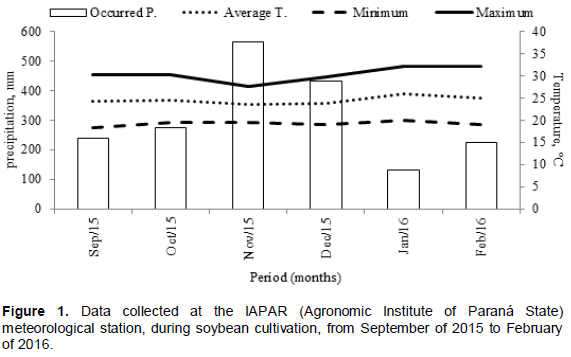
Juliatti et al. (2011) stress that the biggest impacts of white mold are reported in the highland areas, above 700 m high, where night time temperatures are milder, especially in areas with no crop rotation, with host plants and with a reduced amount of straw. There were similar conditions in the experimental area, which had mild temperatures and an area with 735 m of altitude. Following the sowing, there were rainfall and temperature conditions favorable to germination, very common in the Southern Region of Brazil (Mertz et al., 2009). The plants emergence was not influenced by the seed treatment used, however, the height of seedlings and the field emergence were lower for the treatment with Certeza® - (thiophanate methyl + fluazinam), being below the average in both assessments performed (Table 1).
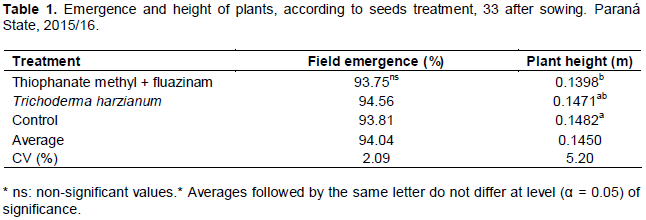
Sid-Ahmed et al. (2003), in assessing the influence of peat and chitin in combination and not combined with biological agents, concluded that the association of microorganisms, as Trichoderma harzianum, enhanced the germination levels, due to the increase in antagonistic potential against pathogens. However, in the current experiment, the treatment of seeds with Trichoderma harzianum, did not promote significant increases on the germination levels and the plants height, being considered similar to the other treatments. It was none the less the treatment which presented the highest germination rate among all treatments. For the disease severity variable, there was no detection of white mold incidence in any of the treatments in the first assessment (R1). In fact, the infection of S. sclerotiorum on the plant starts on the R1 stage, where the crop is more susceptible to diseases, as the ascospores need an exogenous source of energy, originating from the senescing flowers of the plant, which, in favorable meteorological conditions, start the infection process of the plants (Boland and Hall, 1994).
The severity assessments in the subsequent phases, R3 and R5.5, showed that there was an increase in severity over time (Figure 2), with differences for the fungicides application on the R3 stage (Figure 2A) and for the seeds treatments on the R5.5 stage (Figure 2B). According to Almeida et al. (2005), the most vulnerable stage of the soybean plants to white mold incidence comprises R2 to R3. For a greater efficiency in the chemical control of the white mold, the authors recommend the first application to be made at R1, as at this stage there is still a gap between lines, which allows a bigger coverage and a greater quality on the fungicide application. Both on the assessment in R3, as on the assessment in R5.5, the active ingredient thiophanate methyl showed potential in the decrease of the severity of S. sclerotiorum, either on the seed treatment or on the aerial application. The assessment in R.3 determined that the lower severities happened with two applications of thiophanate methyl (R1 and R2 stages) with severity level of 2, 92%, being superior to carbendazim fungicide in 70, 02%, which presented severity of 4,17% at the same stage. The application of thiophanate methyl (R1) and procimidone (R2) resulted in a level severity of 1, 67%, value 57, 19% superior to the 2 applications of thiophanate methyl.
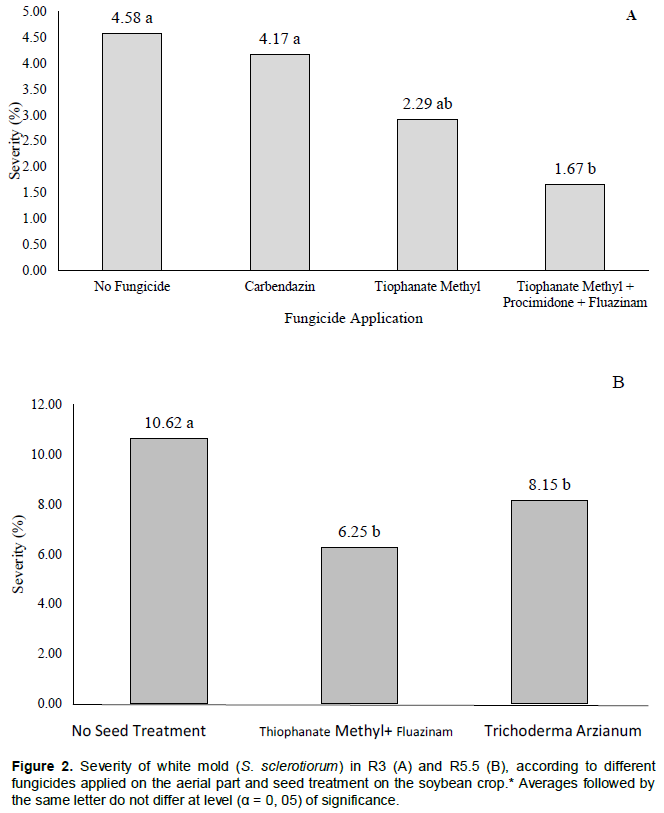
Thiophanate methyl belongs to the chemical group of benzimidazoles, which act on the cellular division, disrupting the mitotic cycle, preventing the formation of the metaphase plate, leading to the collapse of mycelium cells, which terminates the mycelium growth (Juliatti, 2007). However, this specificity of the benzimidazoles causes this fungicide to present high risk of acquired resistance by the pathogen. Due to these characteristics, the isolates resistant to benzimidazoles are generally as adapted as sensitive. Therefore, the high selection pressure caused by intensive usage of benzimidazoles may result in the selection of resistant isolates in a short period of time (Rodrigues et al., 2007). This information is important in the taking up of anti-resistance strategy. Procimidone belongs to the chemical group of dicarboximide, which inhibits the phosphorylation of the respiratory chain, disrupting the transport of electrons, being active from the oxidative phosphorylation (Encinas, 2004).
Meneghetti et al. (2010) stress the importance of using different active ingredients with different mechanisms of action for more effective disease control on the crop, noting that the combination of products increases the action spectrum, providing greater residual, besides decreasing the risk of arising resistant populations. On the assessment of R5.5, the importance of seed treatment in the soybean crop is evident, where it is observed that even under the different active ingredients on the aerial application, the treatments with thiophanate methyl + fluazinam and Trichodermaharzianum, providing control of S. sclerotiorum in soybean crop. Pereira et al. (2009) point out that the seeds are the main transmission vehicle of fungi, which are responsible for the reduction in germination and in vigor, originating the primary outbreaks of the disease.
On studying the incidence of white mold on the soybean crop, Henneberg et al. (2012) used soybean seeds artificially and naturally contaminated during three crops. They concluded that the methods being currently used (filter paper, paper roll and medium Neon-S) for the detection of white mold had not been capable of efficiently exposing the pathogen on naturally infected soybean seeds, highlighting the importance of seed treatment on the crop. On the fourth severity assessment, at the R7 stage, there was a difference between treatments, being that the treatments with thiophanatemethyl + fluazinam and Trichodermaharzianum and fungicide applications on the aerial part thiophanatemethyl, procimidone and fluazinam presented greater efficiency in disease control (Figure 3). On testing the fungicide efficiency in the control of white mold on the area infested by S. sclerotiorum, Vieira et al. (2001) determined that fluazinam was the fungicide which presented the best results for controlling the disease, reducing its severity and the number of S. sclerotiorum produced per plot, corroborating the results below Figure 3.
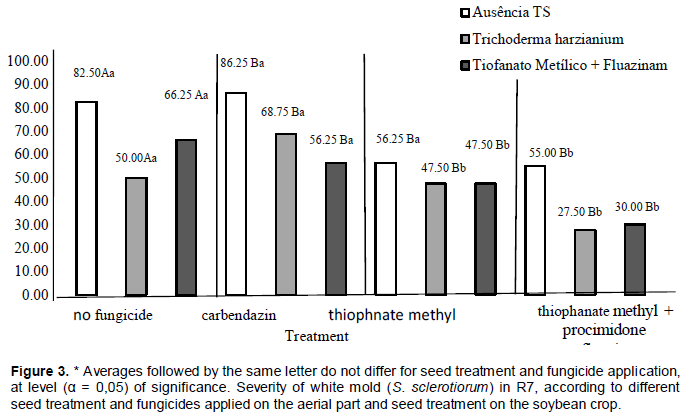
As for the income components, thousand grain weights and productivity, the treatments which presented the lowest levels of severity at the R7 stage, consequently presented the highest levels on the thousand grain weight and productivity (Table 2). The seeds treatment did not provide significant levels for the thousand grain weight and productivity, however, the fungicide applications differed from each other, the superior ones being the treatments with 3 applications of thiophanate methyl and applications of thiophanate methyl, procimidone and fluazinam.

Similarly, Meyer et al. (2013) note better levels of S. sclerotiorum control in the soybean crop with applications ranging from two to four sprayings at 10-day intervals, starting at the R1 stage, with the use of fluazinam (chemical group of fenilpiridinilamin) with procimidone, obtained 67 to 85% of control. Besides this result, another tested result was fluazinam + thiophanate methyl, with 76% of S. sclerotiorum. However, according to the authors, the plots which carbendazim applications presented satisfactory levels. On the plots of the experiment, at the moment of harvesting the blocks with absence of seed treatment presented susceptibility of the crop towards the S. sclerotiorum (Figure 4). As for the economic analysis, despite the treatments which showed the best results in the control of S. sclerotiorum were the treatments with the highest costs, the net income revealed that there were increases in the profitability of the crop, emphasizing the potential of the white mold disease as a cause of losses to the soybean crop. This fact is alarming given the fact that there are estimates that 23% of the area cultivated with soybean in Brazil deals with the presence of S. sclerotiorum, which represents 6.8 million hectares (Meyer et al., 2014). Especially, it was evident that the use of fungicides for seed treatment and together with aerial applications reduces the severity of diseases, providing greater economic return, even with the cost of fungicides.
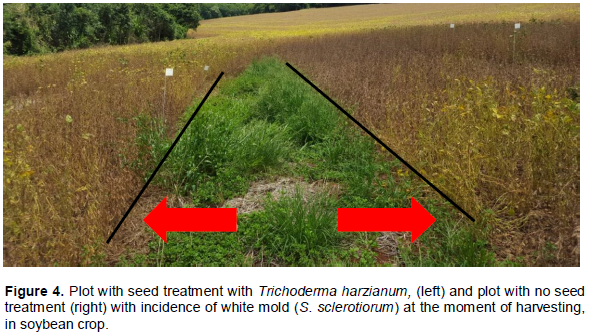
The seeds treatments with thiophanate methyl+fluazinam and with Trichoderma harzianum and the applications of thiophanate methyl, procimidone and fluazinam on the aerial part stood out in the control of the white mold disease.
The fluazinam fungicide resulted in the lowest values of severity of the disease and number of Sclerotinia sclerotiorum. Despite the high cost of fungicides, the income is higher when there is a control of the white mold disease. The efficiency of the control of the white mold is greater when there is an association between the seed treatment and the fungicide application on the aerial part.
The authors have not declared any conflict of interests.
Authors acknowledge the coordinators of improvement of higher Education Personnel (CAPES), National Council for Scientific and Technological Development (CNPq) and Araucaria Foundation for Scientific and Technological Development of Paraná (Araucaria Foundation) for their support.
REFERENCES
|
Almeida AMR, Ferreira, LP, Yorinori, JT, Silva JFV, Henning AA, Godoy CV, Costaminlan LM, Meyer MC (2005). Doenças da soja (Glycinemax). In: Kimati H, Amorin L, Rezende JAM, Bergamin Filho A, Camargo LEA (2005). Manual de Fitopatologia: Doenças de Plantas Cultivadas. 4.ed. São Paulo: Agronômica Ceres Ltda. P 2.
|
|
|
|
Alves Neto AJ, Belmonte C, Neto GM, Gonçalves JRAC (2016). Impactos ambientais no sistema de plantio direto não consolidado. J. Agron. Sci. Umuarama 5:14-25.
|
|
|
|
Boland GJ, Hall R (1994). Index of plants hosts of Sclerotiniasclerotiorum. Can. J. Plant Pathol. 16:93-108.
Crossref
|
|
|
|
Bolton MD, Bart PHJ, Thomma BPHJ, Nelson BD (2006). Sclerotinia sclerotiorum (Lib.) de Bary: biology and molecular traits of a cosmopolitan pathogen. Molec. Plant Pathol. 7:1-12.
Crossref
|
|
|
|
EMBRAPA (2013). Empresa Brasileira de Pesquisa Agropecuária. Centro Nacional de Pesquisa de Solos. Sistema brasileiro de classificação de solos. 3.ed. Brasília. 353p.
|
|
|
|
Encinas O (2004). Conservación de maderas. Trujillo (Venezuela): GICAM – Grupo de Investigación em Conservación de Maderas 22p.
|
|
|
|
Görgen CA, Silveira Neto NA, Carneiro LC, Ragagnin V, Lobo Junir M (2009). Controle do mofo-branco com palhada e Trichodermaharzianum 1306 em soja. Pesqu. Agropec. Bras. 44(12):1583-1590.
Crossref
|
|
|
|
Guo X, Wang D, Gordon SG, Helliwell E, Smith T, Berry SA, Martin SK, Dorrance AE (2008). Genetic mapping of QTLs underlyng partial resistance to Sclerotiniasclerotiorum in soybean PI 391589A and PI 391589. Crop Sci. 48:1129-1139.
Crossref
|
|
|
|
Halfeld-Vieira BA, Sousa RM (2000). Virulência de isolados de Xanthomonas axonopodi spv. phaseolie sua variante fuscans. Ciênc. Agrotéc. 24:94-102 .
|
|
|
|
Henneberg L, Grabicoski EMG, Jaccoud-Filho DS, Panobianco M (2012). Incidência de Sclerotiniasclerotiorum em sementes de soja e sensibilidade dos testes de detecção. Pesqu. Agropec. Bras. Bras. 47(6):763-768.
Crossref
|
|
|
|
IAPAR (Instituto Agronômico do Paraná) (2016). Cartas climáticas do Paraná Disponível em.
View
|
|
|
|
Ito MF, Parisi, JJD (2010). Mofo Branco: Doença que exige muita atenção principalmente no período outono inverno. Disponível em.
View
|
|
|
|
Juliatti FC (2007). Modo de ação dos fungicidas sobre plantas e fungos. Disponível em.
|
|
|
|
Juliatti FC (2010). Podridão branca da haste da soja: Manejo e uso de fungicidas em busca da sustentabilidade nos sistemas de produção. Uberlândia: Composer 2:29.
|
|
|
|
Juliatti FC, Rezende AA, Santos RR, Caires AM, Jaccoud Filho DS (2011). Manejo Sustentável. Cultivar – Grandes Culturas. Pelotas, RS: Grupo Cultivar de Publicações 147:12-12.
|
|
|
|
Leite RMVB (2005). Ocorrência de doenças causadas por Sclerotinia sclerotiorum em girassol e soja. Embrapa soja. Londrina, PR.
|
|
|
|
Maude RB (1996). Seedborne diseases and their control: principles and pratice. Wallingford, CAB International 280p.
|
|
|
|
Meneghetti RC, Balardin RS, Dalla Corte G, Favera DD, Debona D (2010). Avaliação da ativação de defesa em soja contra Phakopsorapachyrhizi em condições controladas. Ciênc. Agrotecnol. 34(4):823-829.
Crossref
|
|
|
|
Mertz LM, Henning FA, Zimmer PD (2009). Bioprotetores e fungicidas químicos no tratamento de sementes de soja. Ciênc. Rural 39(1):13-18.
Crossref
|
|
|
|
Meyer MC, Campos HD, Godoy CV, Utiamada CM (2014). (Ed.). Ensaios cooperativos de controle químico de mofo-branco na cultura da soja: safras 2009 a 2012. Londrina: Embrapa Soja 100p. (Embrapa Soja. Documentos, 345).
|
|
|
|
Meyer MC, Campos HD, Nunes Junior J, Venancio WS, Godoy CV (2013). Chemical control of white mold (Sclerotiniasclerotiorum) on soybean in Brazil. Acta Phytopathol. Sin. 43:10-137.
|
|
|
|
Paula Junior TJ, Venzon M (2007). 101 Culturas – Manual de Tecnologias Agrícolas. EPAMIG, Belo Horizonte. 800p.
|
|
|
|
Pereira CE, Oliveira JA, Rosa MCM, Oliveira GE, Costa Neto J (2009). Tratamento de fungicida de sementes de soja inoculadas com Colletotrichumtruncatum. Ciência Rural Santa Maria 39(9):2390-2395.
Crossref
|
|
|
|
Rodrigues MBC, Andreate FD, Spósio MB, Vildoso CIA, Araújo WL, Kleiner AAP (2007). Resistência a benzimidazóis por Guignardiacitricarpa. Pesqu. Agropec. Bras. Bras. 42 (3): 323-327.
Crossref
|
|
|
|
Saharan GS, Mehta N (2008). Sclerotinia diseases of crop plants: biology, ecology and disease management. Springer New Delhi 486p.
Crossref
|
|
|
|
Sartori FF, JaccoudFilho DS, Manosso Neto M, Vrisman CM, Hennenberg L, Grabicoski EMG, Cantele MA, Pierre MLC, Berger Neto A, Cantele LE, Hüller GC, Tullio AE, Rocha CH, Demarch VB (2011). Análise, distribuição e quantificação do mofo branco (Scletorinia sclerotiorum) em diferentes regiões produtoras do Estado do Paraná. XLIV Congresso Brasileiro de Fitopatologia, Bento Gonçalves – RS. 1340p.
|
|
|
|
Sid-Ahmed A, Ezziyyani M, Sánchez CP, Candela ME (2003).Effect of chitin on biological control activity of Bacillus spp. and Trichodermaharzianum against root rot disease in pepper (Capsicum annuum) plants. Eur. J. Plant Pathol. 109(6):633-637.
Crossref
|
|
|
|
Silva FPM, Gavassoni WL, Bacchi LMA, Garcez FR (2011). Germinação carpogênica de Sclerotinia sclerotiorumsob diferentes resíduos e extratos de plantas cultivadas. Summa Phytopathol. 37(3):131-136.
Crossref
|
|
|
|
Vieira RF, Paula Júnior TJ, Peres AP, Machado JC (2001). Fungicidas aplicados via água de irrigação no controle do mofo-branco no feijoeiro e incidência do patógeno na semente. Fitopatol. Bras. 26:770-773.
Crossref
|
|
|
|
Vuong TD, Diers BW, Hartman GL (2008) Identification of QTL for resistance to sclerotinia stem rot in soybean plant introduction 194639. Crop Sci. 48:2008.
Crossref
|